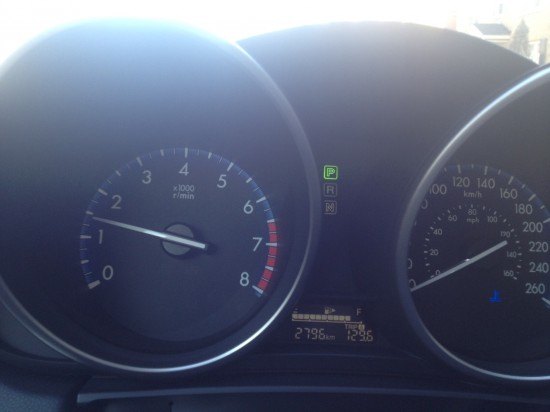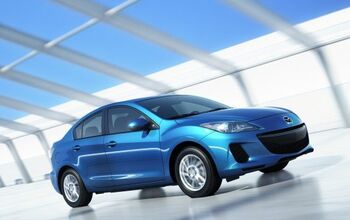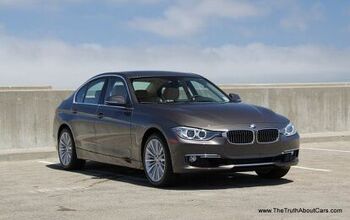Review: 2012 Mazda3 SKYACTIV Take Two
A mere 72 hours after I picked up my Mazda3 SKYACTIV hatchback with the 6-speed automatic transmission, Mazda informed me that they had a 6-speed manual transmission hatch available, and that I was welcome to return the automatic version in exchange for the stickshift. The next day, I dropped off the white automatic for a bright blue manual version. What a mistake.
It’s not that the manual transmission is bad. Far from it. The shift action is crisp, direct and satisfying, with an easy to operate clutch. If I were to buy this car, I would opt for it because I love driving manual. But let’s be clear; claims from other outlets that this gearbox apes the MX-5 are wishful thinking at best, hyperbole at worst. I know this because I own a Miata. It also does not measure up to the wonderful 6-speed automatic offered in this car.
Using a combination of a torque converter and clutch plates, Mazda has created a gearbox that upshifts seemlessly and downshifts with the intensity of an early Volkswagen DSG transmission. While the manual requires a slightly awkward 6-4 downshift to pass anyone on the highway, pressing firmly on the accelerator, or using the +/- manual override feature helps the Mazda3 get out of its own way much quicker.
With 155 horsepower and 148 lb-ft of torque, the SKYACTIV 2.0L 4-Cylinder puts up decent numbers for its class, but has a few unavoidable idiosyncrasies. Start-up, particularly on a cold morning is loud, with an idle approaching 2000 rpm (as shown above) as the engine heats up. Ostensibly this is done in the name of fuel economy and emissions, but dropping it in gear and driving away before the car is warmed up neutralizes this effect. Torque below 3000 rpm is tepid, but the engine itself isn’t unpleasant as it builds to its 6500 rpm redline.
The middling powerplant is redeemed by a chassis and steering that, in the words of Chuck Sheen, makes the competition look like “droopy, armless children.” The Elantra may have the lock on fuel economy and the Focus may be the most upscale, but the Mazda3 is the driver’s choice in this segment by far. Well-weighted, precise steering and a chassis that provides ample feedback are the highlights here, and even Michelin Alpin snow tires couldn’t dampen the car’s enthusiasm for highway ramps and rural backroads. The one drawback is a slightly firm ride that may surprise economy car buyers looking for A-B transportation. If you’re an automotive journalist looking for a Miata with a back seat, this is the one you want.
Anecdotal evidence suggests that a certain segment of consumers are looking for an escape from the overly tech-laden cars of today, and the Mazda3 should be their first stop. The cabin, clad largely in black hard plastic with a smattering of buttons, is so low tech that it seems to be making a Luddite fashion statement. SYNC, BlueLink, OnStar – you won’t find any of that in the Mazda3. You don’t even get a USB port here – in Canada, where the SKYACTIV comes only one way (as a mid-grade GS model, one step down from the Grand Touring trim), an iPod connector harness is a $450 option. There is an auxiliary jack (my favorite method of “infotainment connectivity”) and Bluetooth is standard, along with cruise control, A/C, heated seats (which work very well in frigid Canadian winter temperatures). Braggarts, technology whores and automotive forum junkies may not be able to yammer on about all the superfluous crap that’s available on other competitors, but I admire the Mazda3’s simplicity – some would even say purity. With that said, the interior materials are dated, if we’re being diplomatic. The flip-up plastic cover in the center console felt like it was liable to snap off at a moment’s notice, and some of the dash materials felt like they were made from polystyrene scale model bodies.
Fuel economy has always been the Mazda3’s big sticking point, and the SKYACTIV was meant to fix this issue. Mazda claims that fuel economy for the hatchback is 28/39 mpg for the automatic and 27/38 mpg for the manual. During our 4 days with the automatic, we managed 25 mpg in town (about 133 miles in total), and our manual returned 26 mpg over 342 miles, including a 115 mile highway drive. Mazda’s Canadian ratings are even higher, with Transport Canada advertising 37/55 imperial MPG (30/45 US MPG) and touting as much as 58 mpg Imperial (48 US mpg highway) in the automatic sedan. Needless to say, we didn’t come close.
In the US, the equivalent model retails for $19,300, with the equivalent sedan about $600 less. That puts it smack around the equivalent Cruze, and Elantra, and $1,000-$2,000 less than the equivalent Focus. There are lots of good cars in the compact segment. The Ford Focus offers something for everyone. The Chevrolet Cruze and Hyundai Elantra aren’t as engaging to drive but are more “grown up” options. The Civic and Corolla are the fallback choices while the Subaru Impreza has all-wheel drive. The big problem for the SKYACTIV is that all the driving chops in the world may not be enough to overcome the goofy styling and the sub-standard (if pleasingly simple) interior. I’d buy one – but when have auto journalists ever been representative of the buying public?
More by Derek Kreindler
Latest Car Reviews
Read moreLatest Product Reviews
Read moreRecent Comments
- HotRod Not me personally, but yes - lower prices will dramatically increase the EV's appeal.
- Slavuta "the price isn’t terrible by current EV standards, starting at $47,200"Not terrible for a new Toyota model. But for a Vietnamese no-name, this is terrible.
- Slavuta This is catch22 for me. I would take RAV4 for the powertrain alone. And I wouldn't take it for the same thing. Engines have history of issues and transmission shifts like glass. So, the advantage over hard-working 1.5 is lost.My answer is simple - CX5. This is Japan built, excellent car which has only one shortage - the trunk space.
- Slavuta "Toyota engineers have told us that they intentionally build their powertrains with longevity in mind"Engine is exactly the area where Toyota 4cyl engines had big issues even recently. There was no longevity of any kind. They didn't break, they just consumed so much oil that it was like fueling gasoline and feeding oil every time
- Wjtinfwb Very fortunate so far; the fleet ranges from 2002 to 2023, the most expensive car to maintain we have is our 2020 Acura MDX. One significant issue was taken care of under warranty, otherwise, 6 oil changes at the Acura dealer at $89.95 for full-synthetic and a new set of Michelin Defenders and 4-wheel alignment for 1300. No complaints. a '16 Subaru Crosstrek and '16 Focus ST have each required a new battery, the Ford's was covered under warranty, Subaru's was just under $200. 2 sets of tires on the Focus, 1 set on the Subie. That's it. The Focus has 80k on it and gets synthetic ever 5k at about $90, the Crosstrek is almost identical except I'll run it to 7500 since it's not turbocharged. My '02 V10 Excursion gets one oil change a year, I do it myself for about $30 bucks with Synthetic oil and Motorcraft filter from Wal-Mart for less than $40 bucks. Otherwise it asks for nothing and never has. My new Bronco is still under warranty and has no issues. The local Ford dealer sucks so I do it myself. 6 qts. of full syn, a Motorcraft cartridge filter from Amazon. Total cost about $55 bucks. Takes me 45 minutes. All in I spend about $400/yr. maintaining cars not including tires. The Excursion will likely need some front end work this year, I've set aside a thousand bucks for that. A lot less expensive than when our fleet was smaller but all German.










































Comments
Join the conversation
Got one (non sky activ) as a rental. Real fun car to drive, I could see how this would affect mpg. Only complaint is the ride is hard esp. on bad roads.
To bad the reviewer didn't get more of a chance to drive the automatic with "skyactive". I just made the mistake of purchasing one. Everything seems to run OK most of the time. It's not as zippy as the Acura Integra I had before but I knew that. The problem happens when I hit the gas after driving along at a slow steady speed such as driving in traffic on a small road and turning on to a short highway ramp where I want to accelerate. Hit the gas, engine revs, car does not move. I brought the car back to the dealer. This is "normal". Has to do with the Skyactive. I can upgrade to the 2.2 for 5K. How can Mazda design a car that does this? I see this as dangerous. What if I needed to accelerate to get out of the way.